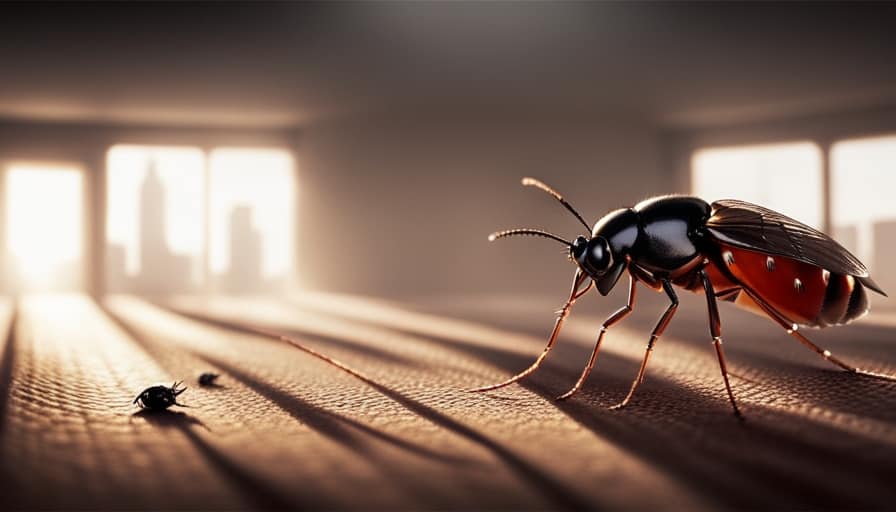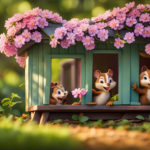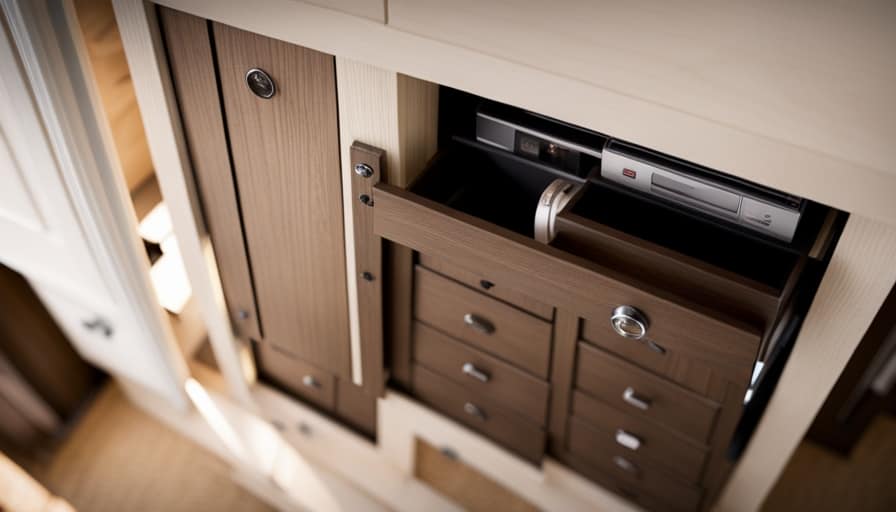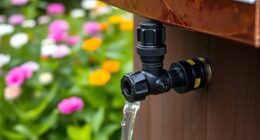Welcome to our guide on the 7 secrets to successful tiny house living! Prepare to discover the practical advantages, downsizing tips, and sustainable practices that will revolutionize your lifestyle.
With clever storage solutions, financial freedom, and eco-friendly practices, you’ll maximize space and minimize stress. Designing for functionality and simplifying your life through minimalism, you’ll discover the joy of every square foot.
Embrace off-grid living, overcome challenges, and create your own self-sustainable haven. Let us serve you with the knowledge and inspiration you need to thrive in your tiny home adventure.
Key Takeaways
- Utilize hidden storage options and space-saving furniture to maximize space and storage in a tiny house.
- Create a comprehensive financial plan, track income and expenses, and prioritize needs over wants to achieve financial freedom and a frugal lifestyle.
- Incorporate sustainable materials, energy-efficient appliances, and eco-friendly practices to live a more sustainable and environmentally friendly lifestyle in a tiny house.
- Embrace minimalist design principles, utilize space-saving furniture and storage solutions, and focus on functionality to achieve a simple and clutter-free living environment in a tiny house.
Maximizing Space: Clever Storage Solutions
We can make the most of our limited space by utilizing clever storage solutions. In tiny houses, every inch counts, so it’s crucial to find innovative ways to store our belongings.

One effective strategy is to maximize hidden storage options. For example, we can install built-in drawers under staircases or utilize storage compartments in furniture pieces. This allows us to keep our items organized and easily accessible without taking up valuable floor space.
Another great idea is to invest in space-saving furniture. Multi-functional pieces like sofa beds, foldable tables, and wall-mounted desks can serve multiple purposes and be easily tucked away when not in use.
Financial Freedom: Saving Money and Cutting Expenses
When it comes to achieving financial freedom in a tiny house, budgeting becomes crucial. By carefully tracking our expenses and setting realistic goals, we can ensure that our money is being spent wisely.
Additionally, adopting a frugal lifestyle can greatly contribute to cutting down on unnecessary expenses and saving more money for the things that truly matter.
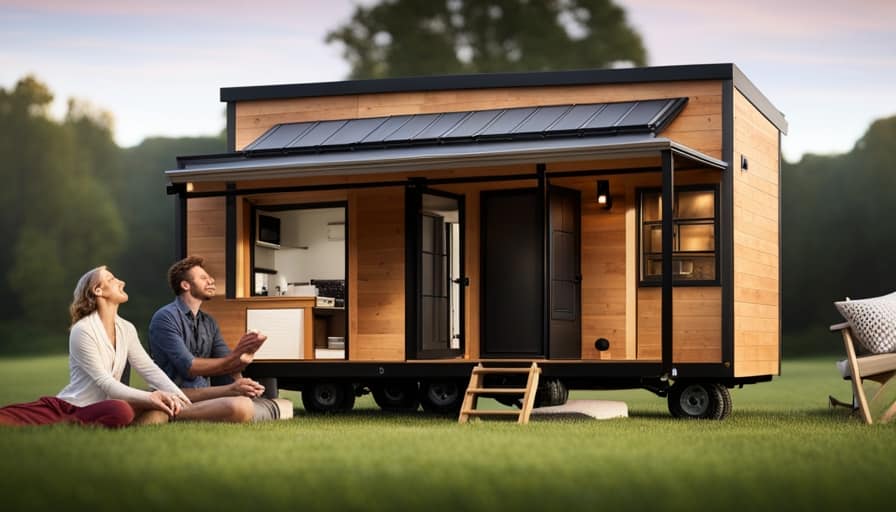
Budgeting for Tiny Living
Living in a tiny house can significantly help us in saving money and cutting expenses. One of the key saving strategies for tiny living is to create a comprehensive financial plan. This involves carefully tracking our income and expenses, and setting clear financial goals. By doing so, we can identify areas where we can cut costs and make necessary adjustments to our spending habits.
Additionally, downsizing to a tiny house means reducing our reliance on material possessions, which can lead to significant savings. We can also explore alternative ways to save money, such as growing our own food, using renewable energy sources, and minimizing our utility bills.
By budgeting effectively and adopting these saving strategies, we can achieve financial freedom and enjoy the benefits of tiny living.
Now, let’s delve into some frugal lifestyle tips to further enhance our savings.
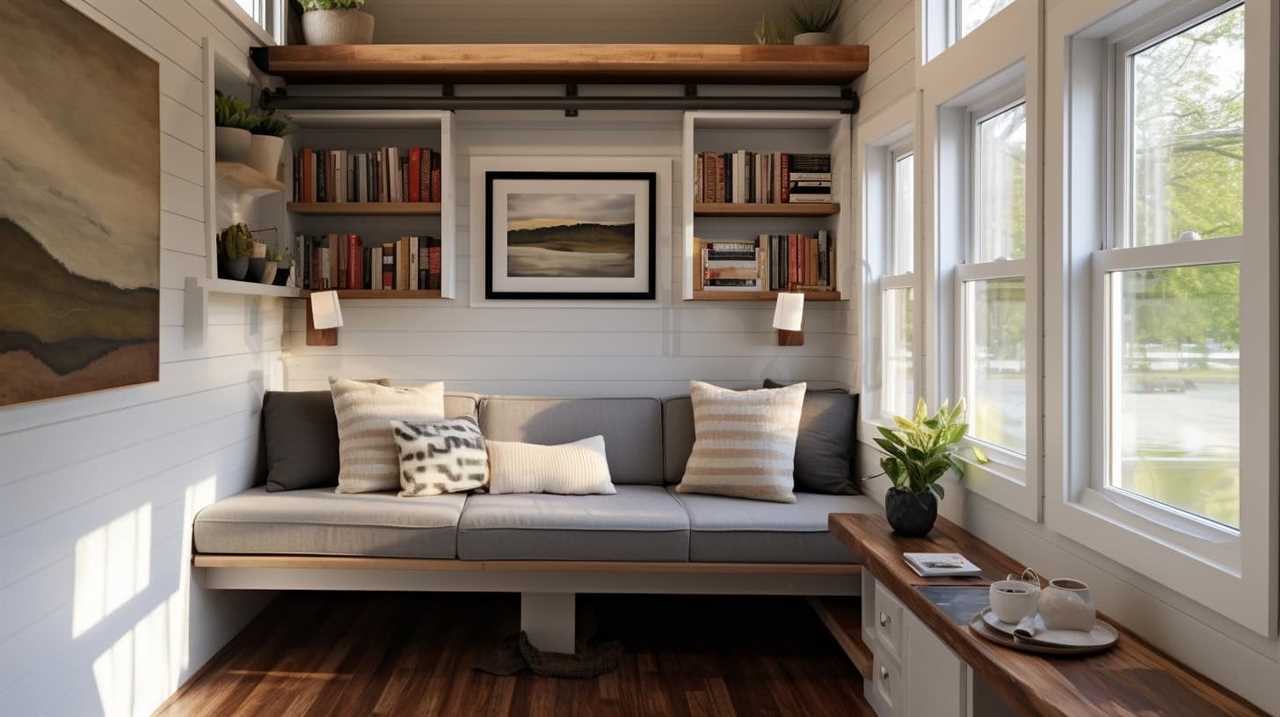
Frugal Lifestyle Tips
Our main goal for achieving financial freedom is to cut expenses while still maintaining a comfortable and fulfilling lifestyle.
One of the most effective ways to do this is through frugal shopping and implementing cost-saving measures. When it comes to frugal shopping, it’s important to be mindful of our spending habits and prioritize needs over wants.
This means creating a shopping list and sticking to it, avoiding impulse purchases, and comparing prices before making a decision. Additionally, we can take advantage of sales, discounts, and coupons to save money on groceries, household items, and clothing.
Another cost-saving measure is to reduce energy consumption by using energy-efficient appliances, unplugging electronics when not in use, and making simple changes like using LED light bulbs.
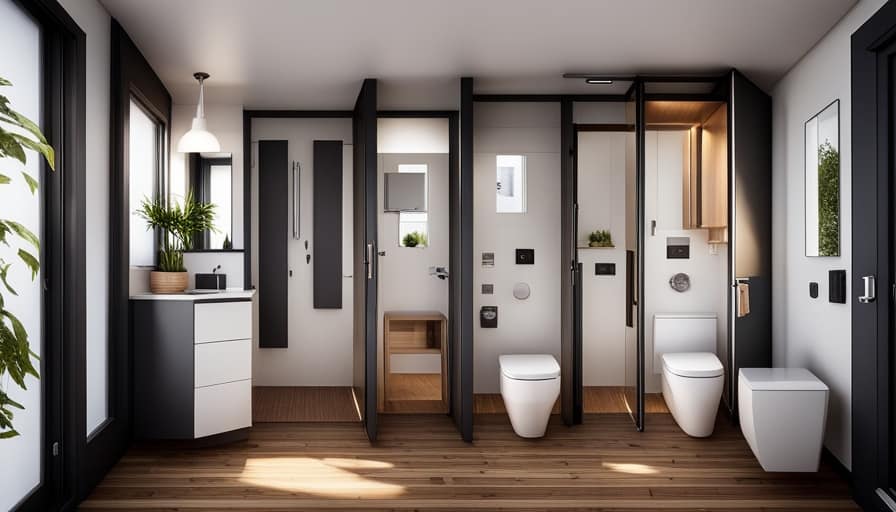
Sustainable Living: Eco-Friendly Practices
With a focus on reducing waste and conserving resources, we can adopt eco-friendly practices that contribute to sustainable living in our tiny homes. One of the key aspects of sustainable living in a tiny house is green building. This involves using sustainable materials, such as reclaimed wood, recycled materials, and low-toxicity paints and finishes. By using these materials, we can minimize our ecological footprint and ensure that our tiny homes are environmentally friendly.
Additionally, incorporating energy-efficient appliances and systems, such as solar panels and rainwater harvesting systems, can further enhance the sustainability of our tiny homes. By implementing these eco-friendly practices, we can create a more sustainable living environment while also reducing our impact on the planet.
As we move on to the next section about designing for functionality, it’s important to keep in mind how these sustainable practices can also contribute to maximizing the functionality of our tiny homes.
Designing for Functionality: Making Every Square Foot Count
Let’s make the most of every square foot by designing our tiny house for maximum functionality. One key aspect of designing a tiny house is embracing minimalist design principles. By keeping the design simple and clutter-free, we can create an open and spacious feel, even within a small space.
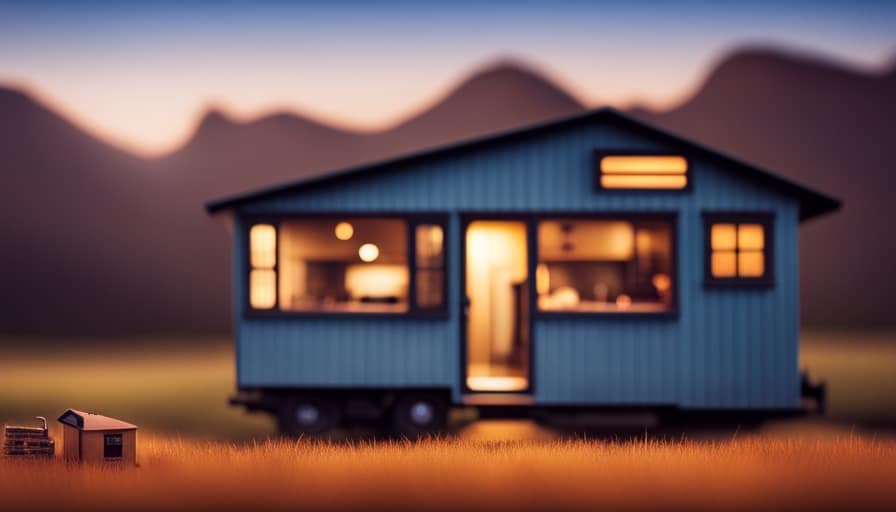
Utilizing space-saving furniture is another essential element in maximizing functionality. Look for multi-purpose furniture that can serve multiple functions, such as a sofa that can also be used as a bed or storage ottomans that can double as seating.
Built-in furniture and storage solutions are also great options for saving space. By carefully planning and designing our tiny house with functionality in mind, we can create a comfortable and efficient living space.
Simplifying Your Life: Minimalism and Decluttering
We can achieve a simpler and more organized lifestyle by embracing minimalism and decluttering.
One way to incorporate minimalism into our lives is through minimalist decor. This involves choosing furniture and accessories that are functional and have a simple, clean design. By focusing on quality over quantity, we can create a space that feels spacious and calming.

In addition to minimalist decor, implementing organizing techniques is key to maintaining a clutter-free environment. This can include utilizing storage solutions such as baskets, bins, and shelves to keep items organized and out of sight. Regular decluttering sessions are also important in order to prevent accumulation of unnecessary items.
Off-Grid Living: Energy Independence and Self-Sustainability
Our goal is to achieve energy independence and self-sustainability through off-grid living. One of the key aspects of achieving this is by using energy-efficient appliances. By opting for appliances that are specifically designed to consume less energy, we can significantly reduce our electricity consumption. This not only helps us save money in the long run but also reduces our carbon footprint.
Additionally, incorporating renewable energy sources such as solar panels or wind turbines can further enhance our self-sustainability. These sources of energy are clean, abundant, and environmentally friendly. By harnessing the power of the sun or wind, we can generate our own electricity and reduce our reliance on traditional power grids.
Transitioning to off-grid living allows us to take control of our energy consumption and contribute to a more sustainable future.
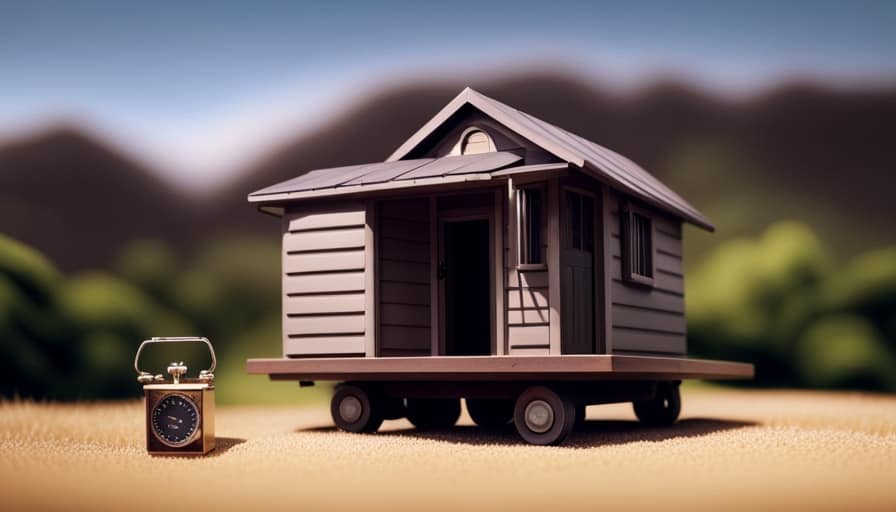
Now let’s explore the challenges of navigating zoning laws and building regulations.
Overcoming Challenges: Navigating Zoning Laws and Building Regulations
When it comes to living in a tiny house, one of the biggest challenges is navigating zoning laws and building regulations. It’s important to ensure that you’re in compliance with all permits and regulations to avoid any legal issues.
To overcome this challenge, we need to strategize and find ways to work within the existing zoning laws. This could involve building on a foundation, as some areas have different regulations for permanent structures compared to movable structures. By constructing your tiny house on a foundation, you may be able to classify it as a permanent structure, which could make it easier to comply with local zoning laws.
Another approach is to find land in areas where tiny houses are allowed. Some municipalities have specific areas or neighborhoods where tiny houses are permitted, either as a primary residence or as accessory dwelling units. Researching these areas and finding suitable land can help you avoid zoning issues altogether.
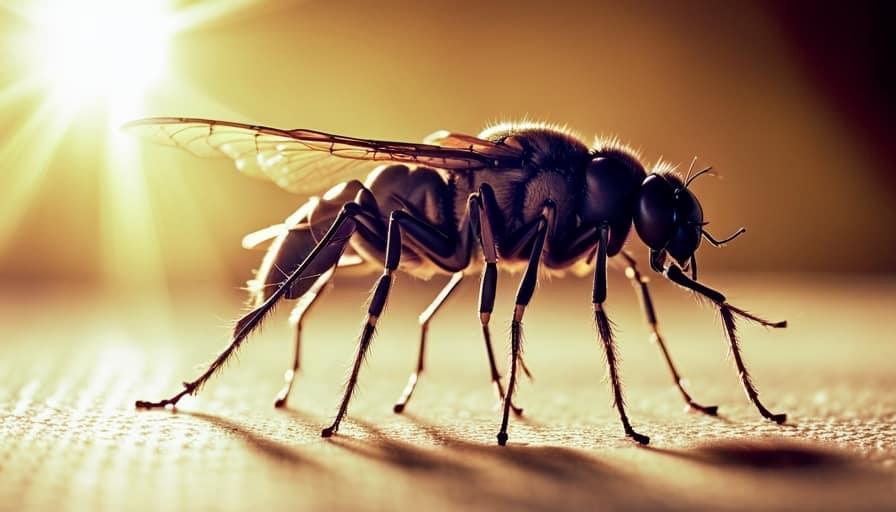
In addition, it’s important to stay informed about any changes or updates to zoning laws and regulations. These laws can vary from one jurisdiction to another, so it’s crucial to be aware of any new requirements or restrictions that may affect your tiny house.
Permits and Regulations: Compliance
One of the most important aspects of tiny house living is understanding and complying with the various permits and regulations that govern the construction and placement of these homes. Navigating the legal requirements can be challenging, but it’s essential to ensure a smooth and hassle-free experience.
To overcome these obstacles, it’s crucial to research and familiarize yourself with the specific zoning laws and building regulations in your area. Contact your local government offices or planning departments to obtain the necessary permits and understand the requirements for tiny house construction and placement.
It’s also advisable to consult with professionals, such as architects or builders experienced in tiny house construction, who can guide you through the process and help ensure compliance with all regulations.
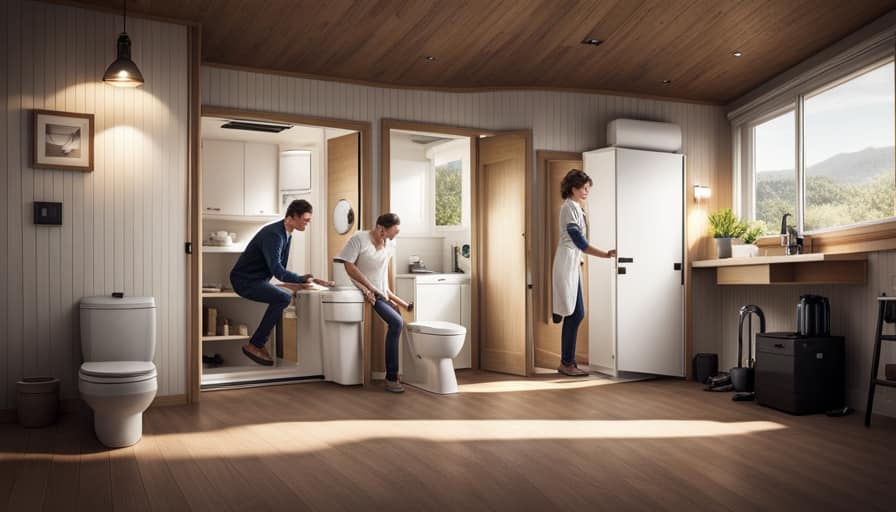
Navigating Zoning Laws: Strategies
We can navigate zoning laws by understanding the regulations and working with professionals experienced in tiny house construction. When it comes to finding affordable land for your tiny home, there are a few strategies you can employ.
First, consider looking for land in rural areas or outskirts of towns, where zoning laws may be more lenient. You can also explore the option of leasing land from a local farmer or landowner.
Another strategy is to join or create a tiny house community, where like-minded individuals come together to purchase a larger plot of land and divide it into smaller lots for individual tiny homes.
Working with local communities is crucial in navigating zoning laws. It’s important to communicate openly with your neighbors and local officials, and educate them about the benefits of tiny house living. Building positive relationships and demonstrating the positive impact your tiny home can have on the community can go a long way in overcoming zoning challenges.
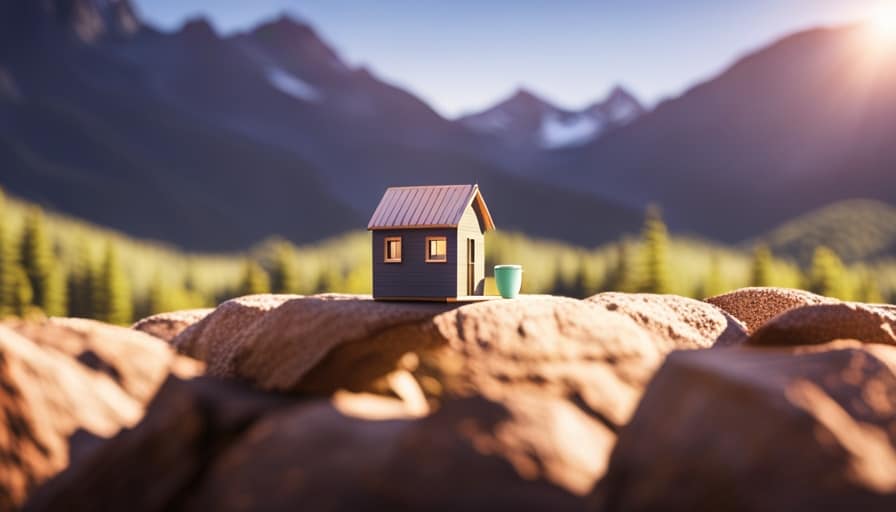
Frequently Asked Questions
How Do I Deal With Zoning Laws and Building Regulations When It Comes to Living in a Tiny House?
When it comes to living in a tiny house, dealing with zoning laws and building regulations can be challenging. However, we’ve found that researching local codes, obtaining permits, and working with professionals can help navigate these obstacles.
Are There Any Specific Eco-Friendly Practices That Are Recommended for Sustainable Living in a Tiny House?
In sustainable living, eco-friendly construction and off-grid energy solutions are essential for tiny houses. We can incorporate practices like using recycled materials, installing solar panels, and implementing rainwater harvesting to minimize our ecological footprint.
Can You Provide Tips on How to Maximize Space and Storage Solutions in a Tiny House?
In our experience, maximizing space and storage in a tiny house is all about using space-saving furniture and getting creative with organization ideas. Let us share some tips and tricks we’ve found helpful.
How Can I Achieve Financial Freedom and Save Money by Living in a Tiny House?
To achieve financial independence and save money while living in a tiny house, we recommend implementing budgeting strategies, minimizing expenses, exploring alternative energy sources, and embracing a minimalist lifestyle. These tips can help you achieve your financial goals.

What Are Some Common Challenges That People Face When Living Off-Grid in a Tiny House and How Can They Be Overcome?
Living off-grid in a tiny house presents challenges such as limited space and resource management. However, these can be overcome by maximizing storage solutions, utilizing renewable energy sources, and implementing efficient water and waste management systems.
Conclusion
In conclusion, tiny house living offers numerous practical benefits, from maximizing space with clever storage solutions to achieving financial freedom by cutting expenses.
Embracing sustainable living practices not only benefits the environment but also contributes to a more fulfilling lifestyle. By designing for functionality and simplifying our lives through minimalism and decluttering, we can create a space that truly reflects our values.
Overcoming challenges like navigating zoning laws and building regulations allows us to achieve the dream of off-grid living and self-sustainability.
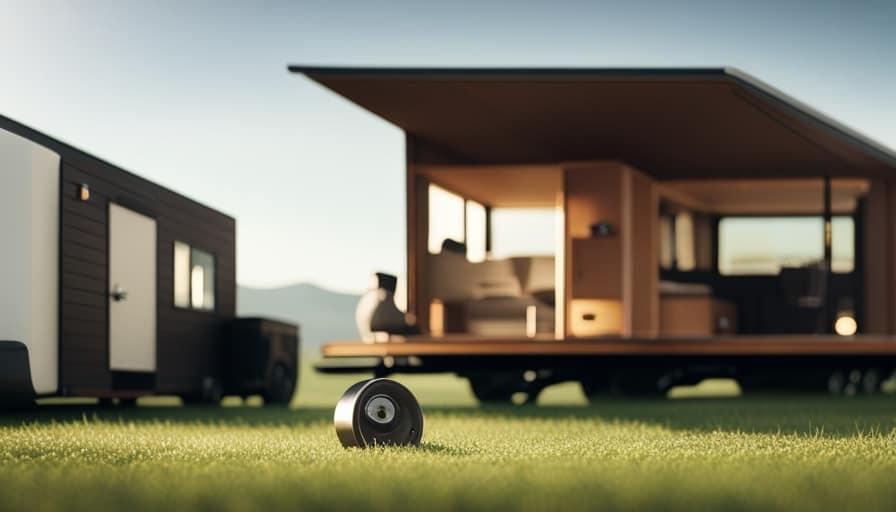
In the end, tiny house living is about more than just downsizing; it’s about embracing a simpler, more intentional way of life.
I’m Theodore, and I love tiny houses. In fact, I’m the author of Tiny House 43, a book about tiny houses that are also tree houses. I think they’re magical places where imaginations can run wild and adventures are just waiting to happen.
While tree houses are often associated with childhood, they can be the perfect adult retreat. They offer a cozy space to relax and unwind, surrounded by nature. And since they’re typically built on stilts or raised platforms, they offer stunning views that traditional homes simply can’t match.
If you’re looking for a unique and romantic getaway, a tree house tiny house might just be the perfect option.
